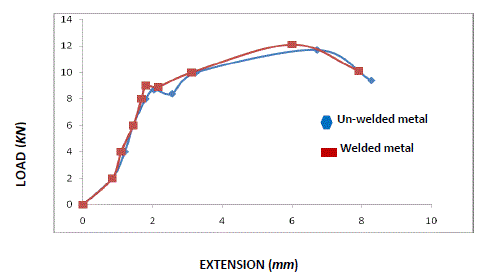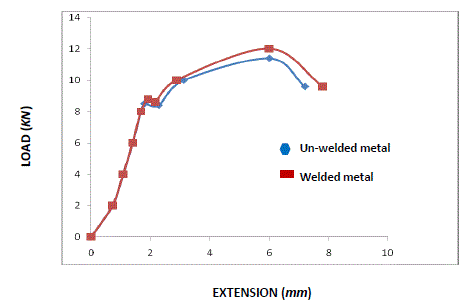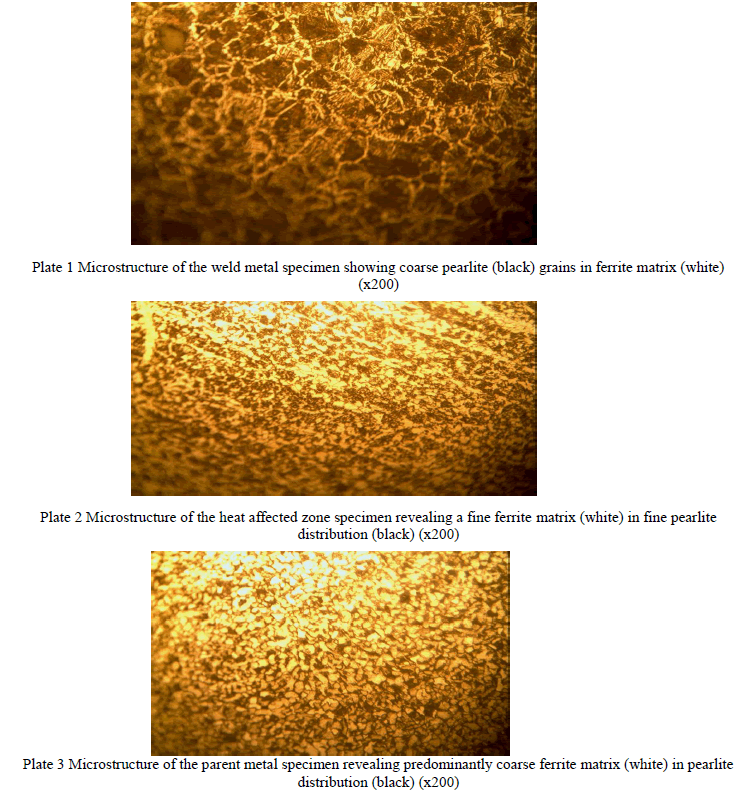ISSN ONLINE(2319-8753)PRINT(2347-6710)
ISSN ONLINE(2319-8753)PRINT(2347-6710)
R. A. Mohammed1, M. Abdulwahab*2, E. T. Dauda3
|
| Related article at Pubmed, Scholar Google |
Visit for more related articles at International Journal of Innovative Research in Science, Engineering and Technology
This work investigated the mechanical and metallurgical properties of medium carbon steel using shielded metal arc welding process (SMAW) with reference to the weld metal, heat affected zone and parent metal. From the results, shielded metal arc welding (SMAW) of medium carbon steel increased the strength of the welded joint in particular the heat affected zone (HAZ), as revealed by lower impact strength, higher tensile strength and hardness values as compared with the parent and weld metal which is attributed to the fine ferrite matrix and fine pearlite distribution as compared to the weld and parent metal. However, there was a loss of ductility at the welded joint resulting to brittleness of the material
Keywords |
| Medium carbon steel, heat affected zone, grain refinement, mechanical properties |
INTRODUCTION |
| Welding is a method of repairing or creating metal structures by joining the pieces of metals or plastic through various fusion processes. Generally heat is used to weld the materials. Welding equipments can utilize flames, electric arc or laser light to produce heat [1]. The earliest evidence of welding can be dated back to the middle ages (Bronze Age). Examples of this were welded gold boxes. Egyptians learnt the art of welding; several of their iron tools were made by welding. During this period a set of specialized workmen called the blacksmiths came to the fore. Blacksmiths of the middle ages welded various types of iron tools by hammering (forge welding). The welding methods remained unchanged until the dawn of the 19th century [1]. Arc welding and oxy-fuel welding were developed late in the century and electric resistance welding followed soon after [2, 3]. After the end of World War 1(1919), the American Welding Society was established with the aim of advancing welding processes. Some of the most recent developments in welding include the friction welding process developed in Russia and the laser welding [1]. However within the past fifty years, there has been a great improvement in the technical and scientific knowledge and equipment in welding. Welding is more economical, convenient and less susceptible to failure or corrosion as compared to other joining processes. Owing to the advantages of welding over other joining process, numerous welding processes have been developed [4]. As an industrial process, the cost of welding plays a crucial role in manufacturing decisions. Many different variables affect the total cost, including equipment cost, labor cost, material cost, and energy cost [5]. Depending on the process, equipment cost can vary, from inexpensive for methods like shielded metal arc welding and oxy-fuel welding, to extremely expensive for methods like laser beam welding and electron beam welding. Because of their high cost, they are only used in high production operations. The cost of materials includes the cost of the base and filler material, and the cost of shielding gases. Finally, energy cost depends on arc time and welding power demand [5]. For manual welding methods, labor costs generally make up the vast majority of the total cost. As a result, many cost-saving measures are focused on minimizing operation time. To do this, welding procedures with high deposition rates can be selected, and weld parameters can be fine-tuned to increase welding speed. Mechanization and automation are often implemented to reduce labor costs, but this frequently increases the cost of equipment and creates additional setup time. Material costs tend to increase when special properties are necessary, and energy costs normally do not amount to more than several percent of the total welding cost [5]. Steel is an alloy of iron and carbon. Steel containing carbon content of 0.30 to 0.45 is referred to as medium carbon steel. These steels are used for making connecting rods, gear shafts, axles, spring clips, wires and rods, automobile engineering, structural engineering, constructions [4]. During applications, these materials are subjected to welding, hence, the effect of welding process on the general mechanical properties of steel needs to be known to ensure effective performance in service condition. Materials are tested for one or more of the following purposes: 1. To determine numerically the mechanical properties i.e. ductility, malleability, hardness, toughness, 2. To determine certain data i.e. stress, strain values to draw up sets of specifications upon which the engineer can base his design, 3. To check chemical composition and to determine the suitability of materials for a particular application. The study of weld metallurgy is very important because the overall mechanical properties, of a weldment are determined by the characteristic properties of individual microstructure present in the weld deposit and the weld heat affected zone. It has been long recognized that one of the major problems associated with welding fabrication arises from the inability to obtain uniform mechanical properties throughout the weldment. Both chemical inhomogeneity and changes in metallurgical structure result during welding operations because most fusion welding processes generates high rates of heating and cooling in the weld metal and parent metal adjacent or the weld [6, 7-11]. In the present study, effort have been made to analyze the mechanical and metallurgical properties of medium carbon steel using shielded metal arc welding process. |
II. EXPERIMENTAL METHODS |
| A. Materials Medium carbon steel rods of dimension of 12 mm diameter were used. The chemical composition of as-received steel material obtained from Spectro Steel Company, Lagos, Nigeria can be found in Table 1: Table 1. Chemical composition of the medium carbon steel rod used |
 |
| An electrode having a rating E6013 and a composition of 0.12%C, 0.1%Si and 0.45%Mn were used. The electrode is coated with titanium-potassium materials which can be operated in all positions. It has a diameter of 3.2 mm and a length of 350 mm which has an advantage of deep penetration. B. Method Mild steel rods of diameter 12 mm were sectioned using a hacksaw and coolant into twenty pieces. Four of the pieces out of the total specimens were un-welded and sixteen were each beveled around the edges with the aid of a grinding machine to an angle of 300 to horizontal. The beveled faces were cleaned properly and smoothened to ensure a sound weld. Heat generated was minimized to avoid changes in the microstructure of the specimen. The faces of two pieces of the beveled rods were placed 5 mm apart from each other, and welding machine was appropriately set. The proper amperage and voltage were set. The electrode was placed in the holder and the welding machine was turned on. The assembly was tack-welded to ensure alignment and an arc was struck. A single bead was made to ensure uniform fusion of the rods. The weld was de-slagged, cleaned and welded again. The finished bead was spread round the joint to ensure proper weld. After the final welding process a grinding machine was used to clean the weld. The specimen was allowed to cool before further investigation was carried out. An analysis of the weldments of medium carbon steel was carried out to determine some mechanical and chemical properties with reference to the parent metal, HAZ and the weld metal. The specimens were machined carefully to the required dimensions for tensile, impact, hardness and microstructure analysis. Excess heat generated was avoided and surface uniformity was ensured when using the lathe machine. |
III. RESULTS AND DISCUSSION |
| A. Results The variation in the load-extension for the first, second and third samples from the parent metal and welded specimen can be found in Figures 1-3. While the micrographs of the weld metal, HAZ and parent metal are presented in Plates 1-3. B. Discussion 1) Weld metal and Heat affected zone (welded specimen) From the micrograph in Plate 1, the microstructure reveals coarse pearlite grains distributed (black) in a ferrite matrix (white) indicating a slow rate of cooling. This slow cooling rate is due to the number of passes/beads applied to the weld during the welding process. Mechanical test on this specimen reveals an average hardness value of 54.0 HRA as compared with the parent metal hardness of 50.1 HRA. Visual observation of the fractured surface shows a less fibrous surface. This shows a decrease in ductility of the specimen as seen. From the micrograph in Plate 2, the microstructure reveals fine ferrite grain matrix (white) in fine pearlite distribution (black) indicating grain refinement. This grain refinement is as a result of the heat generated at the weld. The mechanical evaluation of this specimen shows that its zone has the highest hardness value with an average of 56.3 HRA with a lower impact energy of 39.53 J compared to the un-welded specimen. |
 |
 |
| Fig. 3 Variation of load-extension for the third specimen in the parent metal and the welded specimen superimposed on each other It has tensile and yield strength of 612.24 N/mm2 and 454.08 N/mm2. Hence this shows that this specimen is the least ductile as compared to the parent metal and the welded joint. These have been shown in Figures 1-3. Visual observation of the fractured surface shows a crystalline surface. This indicates that the specimen was brittle and failure occurred with lower plastic deformation as compared to the parent metal and weld metal. The investigation of the effects of shielded metal arc welding on the mechanical and metallurgical properties of medium carbon steel under the present investigation has been able to predict the behavior of the material under examination. This will enabled some metallurgical treatment be carried out in order to make the material withstand failure during service condition. 2) Parent metal (un-welded specimen) From the micrograph in Plate 3, the microstructure reveals predominant coarse ferrite grain matrix (white) in pearlite distribution (black) indicating no changes in microstructure due to heat generated at the weld. Mechanical tests on this specimen show an average hardness value of 50.1 HRA, impact strength of 53.89 J, a tensile and yield strength of 596.64 N/mm2 and 438.78 N/mm2 respectively. Visual observation of the fractured surfaces shows a fibrous surface. This shows that plastic deformation occurred before fracture of the specimen. |
 |
IV. CONCLUSIONS |
| From the results of the investigation, the heat generated by SMAW process promotes mechanical and metallurgical changes along the weld profile. Hence the following conclusions were made: |
| 1. The parent metal (un-welded specimen) had the highest toughness and is the most ductile as compared to the heat affected zone and the weld metal. |
| 2. The weld metal possessed an appreciable amount of hardness and a deep in toughness showing less ductility than the parent metal, but more ductile than the heat affected zone. |
| 3. The heat affected zone possessed the highest hardness, tensile strength and least impact strength showing that it is the most brittle as compared to the weld metal and the parent metal. |
Methods |
| 4. That shielded metal arc welding (SMAW) of medium carbon steel increased the strength of the welded joint in particular the heat affected zone, as revealed by lower impact strength, higher tensile strength and hardness values as compared to the parent and weld metal. |
V. ACKNOWLEDGEMENTS |
| The authors acknowledge with thanks the equipment support of the Department of Metallurgical and Materials Engineering, Ahmadu Bello University, Zaria during the research work. |
References |
|